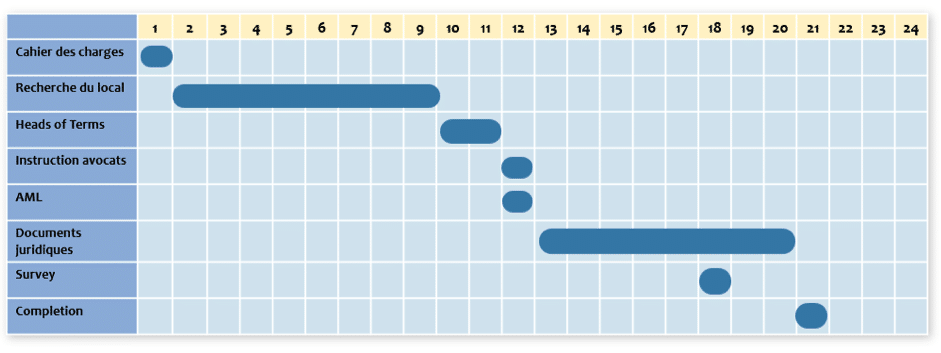
Following our first article on the different types of commercial leases, we will now continue our series on commercial leases in the United Kingdom with a chronological approach to negotiation. How long does it take to sign a commercial lease? What are the different steps? Our experts will tell you all there is to know.
1-Drafting of specifications
Any proper research will begin by drafting detailed specifications. It is necessary to look into the positioning of the business and its clientele. Who are we targeting? What is the typical profile of our customers? What is their purchasing power?
Where do our customers live? Do they work?
Will our business be a pleasure/impulse buying business or a destination business?
Once these questions are clarified, it’s now possible to draw a first map with potential target neighborhoods. Then comes the not to be overlooked question of the budget. How much are we ready to pay for rent (business rates not to be forgotten!)? What will be the budget for fit out?
Finally, it is also important to take into account the operational constraints of our sector of activity. A baker will need three-phase current, a restaurant will need an alcohol license as well as an extraction outlet. It is essential that you are thorough in this process, otherwise unpleasant surprises could come around during the search or even worse, once the contract is signed…
Timing: 1 week
2-Search on the on and off market
Once your specifications have been established, it is high time to look out for premises. This task can be very time-consuming and complicated as the British market is complex and opaque. Indeed, many transactions are made “off-market” without the properties having had time to appear on official listings. It is very important to be accompanied in this process so as not to miss the premises of your dreams! The competition is tough for well-placed premises, especially in London due to the limited supply. An agent will also be able to guide you in negotiating the terms of the contract thanks to their knowledge of market prices. Such collaboration is often a win/win insofar as that the savings made in the negotiation will often be greater than the sum you will pay them.
Timing: everything will depend on the market of course, on your specifications and on your ability to compromise on your initial expectations. Generally, we can identify a suitable property in 8 weeks.
3-“Heads of terms” negotiation
Once the premises have been found, negotiations will begin with the landlord’s agent, who will be making an initial selection before submitting the pre-selected files to the landlord. It is a well-coded ritual during which one must present a “landlord pack”. One has to know how to convince as regards both the interest of the business model and the ability to pay the rent
In addition to the presentation of the business, it will also be necessary to propose an offer that will take up the main lines of the contract (type of lease, rent, security deposit, free rent etc.). These are the “heads of terms”. It is important to note that the “heads of terms” are not legally binding but just show an intention to do business together.
Timing: everything will depend on the speed at which the landlord will want to close the deal but a period of 2 weeks seems reasonable.
4-Instruction of the solicitors
Good news, the “heads of terms” have been accepted!
From that moment on, a new person enters the dance, your solicitor. Even if your agent has negotiated the main terms of the contract, it is not intended to replace the solicitor who will be responsible for drafting the legal documents.
Commercial leases are less codified in England than in France and historically tend to favor the landlord. It is therefore very important to work with a solicitor to avoid unpleasant surprises.
If you have no contacts, it is not a problem. French Touch Commercial has a whole panel of quality partners with whom we work!
Timing: 1 week
5-AML
AML for “Anti Money Laundering”. We also talk about KYC for “Know Your Customer”. While real estate has often been associated with money laundering, much progress has been made in this area. As a consequence of these new regulatory provisions, be prepared to lay yourself bare! You will need to provide identity documents, proof of address, proof of origin of the funds etc. A lot of paperwork but a necessary step to serenely consider the rest of the process.
Timing: 1 week
6-Drafting of the legal documents
We can now get to the heart of the subject of drafting of the legal elements. In most cases, your solicitor will put together 3 documents: the lease, the “deposit deed” and the “license for alterations”.
There will be many statements and he will be working with your agent to clarify what needs to be clarified and negotiate certain clauses that might be too much to the advantage of the landlord.
He will also take care of the searches at the cadastre which will make sure that the premises are duly declared. He will also ensure the right “class of use“.
His work completed, your solicitor will send you a report on the lease summarizing the most important information that will allow you to understand your contractual commitments.
Timing: the duration of “legals” can be particularly long and be impacted by many factors (number of actors concerned, willingness or not to proceed quickly, complexity of the file etc.). It is not uncommon to have to wait 2 months to finalize legal acts.
7-Survey / schedule of condition
Signing a commercial lease will commit you, especially when it comes to a “Full Repairing and Insuring Lease“. It is therefore fundamental to understand your maintenance and repair obligations. In order to avoid unpleasant surprises, it is strongly recommended to have a “schedule of condition” (or inventory) made that would protect you to the extent that the owner cannot require you to return your premises in a better condition than the one in which you found it.
You can also have a more in-depth analysis of your premises with a “survey” which will detail precisely the technical problems of the premises and will propose adapted solutions.
Timing: 1 week
8-Completion lease register SDLT
That’s it, you’re almost there! After all the back and forth between the solicitors, the searches, and the survey, the time to sign has arrived.
It will be necessary to pay beforehand the sums detailed in the “completion statement” (solicitors fees, stamp duty, security deposit etc.) before notifying your solicitor that you agree to proceed with the “completion”, i.e. the final signature and the long-awaited handover of the keys.
Your solicitor will also have to register the lease with the Land Registry.
Timing: 1 day
So how long does it take to get the keys of your premises? On average, it takes about 5 months from the start of the research. This period is obviously indicative and will depend on many variables.
One thing for certain, more and more people in the commercial estate industry are speaking out against a process that has become too complex and too expensive. Some even see it as a danger, especially people working in office real estate who can see their traditional activity having to compete more and more against offers of “serviced offices”, payable on invoice, without the legal complications.
It is therefore not surprising to see some leading players trying to find innovative solutions. Interestingly, some large landlords like Grovesnor offer “simplified leases” which should reduce legal costs by 90%!
This approach will make some teeth grind in the law firms of the City but they can be reassured that the “Full Repairing and Insuring lease” still has a bright future ahead of it!

For further information, do not hesitate to contact us.



